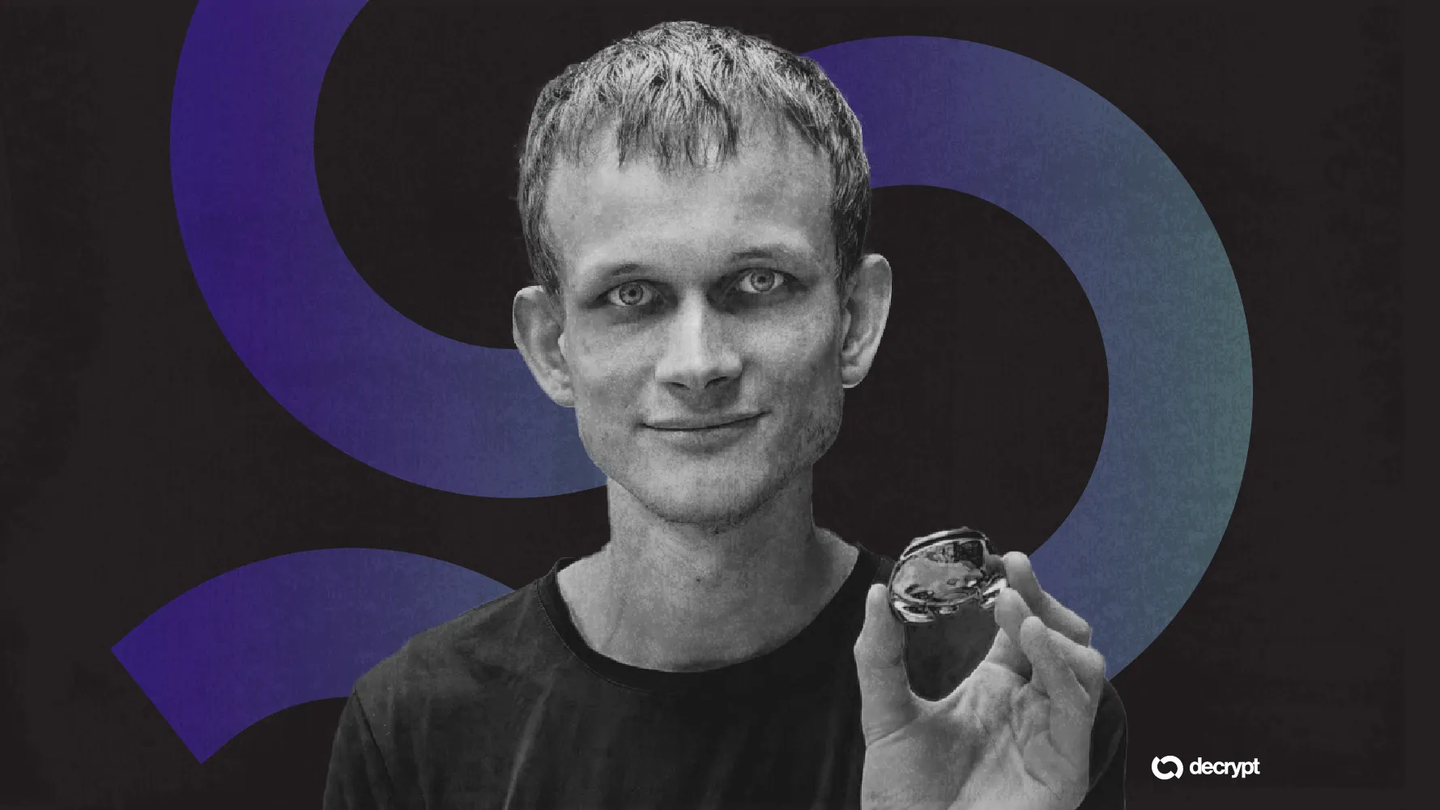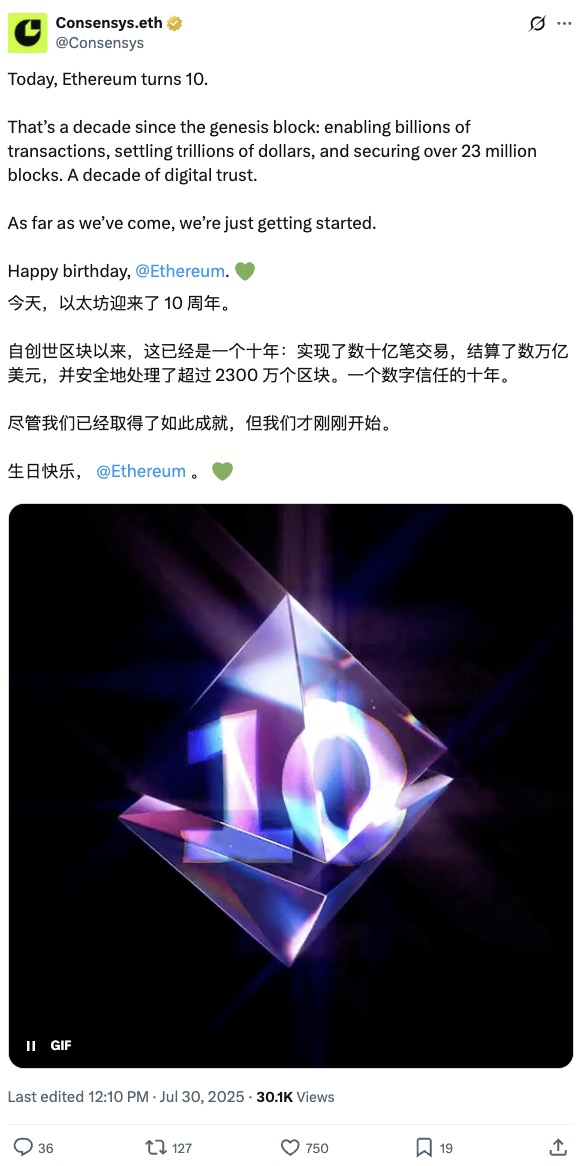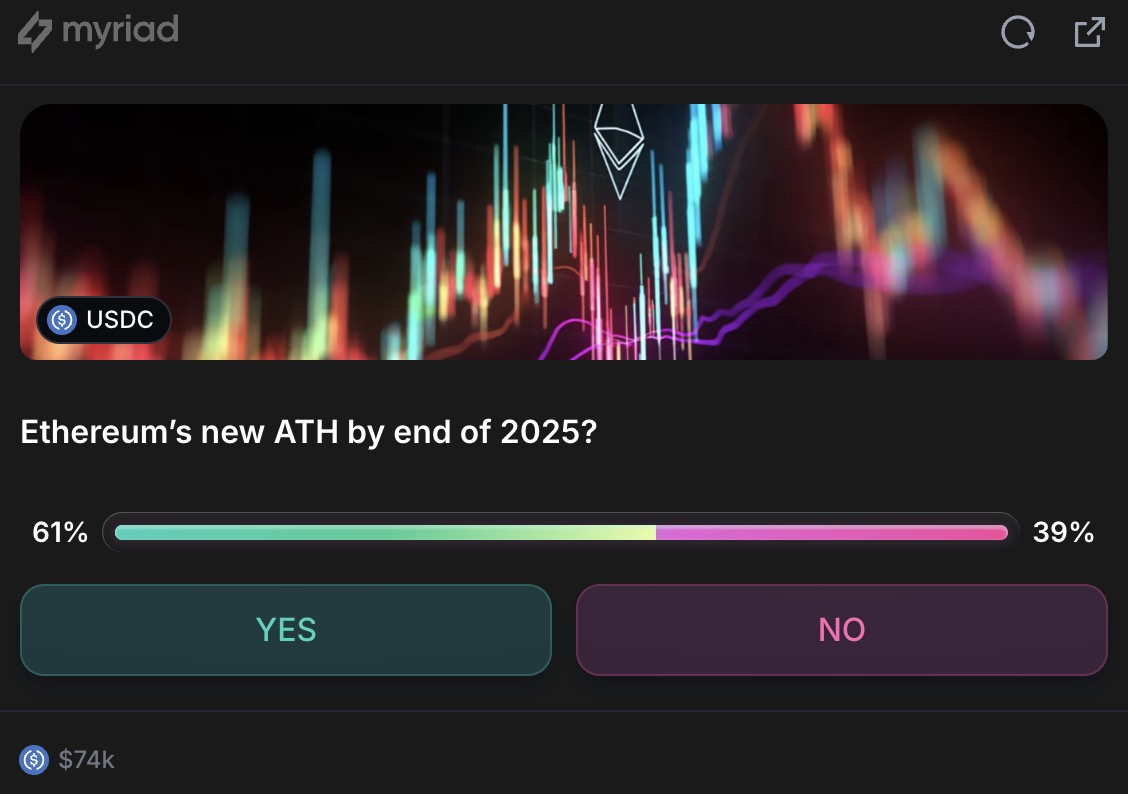Ethereum is set to undergo a series of upgrades and tackle the challenges posed by quantum computing, with advocates believing it will become the "foundational layer of the future global economy."
Author: Ryan S. Gladwin
Translation: Baihua Blockchain
Source: Shutterstock/Decrypt

Ethereum celebrated its tenth anniversary on Wednesday, marking a decade since the birth of its first block. So, what will the next decade look like?
In its first decade, Ethereum has become the second-largest cryptocurrency by market capitalization, successfully addressing existential threats and evolving in various ways.
What can we expect from Ethereum in the next decade? Decrypt interviewed several top Ethereum experts to learn about their predictions.

The Next Five Years
Predictors from Myriad Markets believe there is a 64% chance that Ethereum will hit an all-time high by the end of the year, which would set a positive tone for its second decade—especially considering the current record has remained unbroken since 2021, while Bitcoin and other major cryptocurrencies have reached more recent highs.
Within this timeframe, the network is expected to undergo the Fusaka upgrade, with Bitwise senior research associate Max Shannon estimating that the upgrade will launch in November this year. The current draft of Fusaka will focus on data efficiency, accessibility, and user experience (UX).
According to Ethereum's roadmap, the Glamsterdam upgrade is expected to launch in 2026. Ethereum Improvement Proposal (EIP) editor and Namefi founder Victor Zhou told Decrypt that this upgrade is still in the planning stages but will broadly enhance network capabilities.

"Ethereum L1 will continue to expand, aiming for a tenfold increase in the next 12 months," ConsenSys Chief Strategy Officer Jason Linehan told Decrypt. "This will complement the L2 expansion roadmap, which is progressing faster than ever in terms of interoperability."
Hart Lambur, co-founder of Risk Labs—whose team developed the UMA oracle service and the Across bridging protocol—told Decrypt that interoperability is key to its short-term future.
"Ethereum has achieved scalability through layer two networks, but this has broken the user experience; moving between different chains is still clunky and expensive," Lambur said. "Solving interoperability is a significant milestone ahead. Once interoperability becomes seamless, Ethereum will feel like a unified network again."
As the Ethereum ecosystem moves closer to interoperability, a series of new network upgrades are waiting to be implemented to improve the foundational layer.
"In the next five years, upgrades like 'Surge,' 'Clean,' 'Edge,' 'Purify,' and 'Waste' will bring cheaper transactions, faster processing, stronger MEV (Maximum Extractable Value) protection, and simpler node operations," Unity Wallet COO James Toledano told Decrypt. "While not as eye-catching as the Merge, these changes address long-standing pain points."
The terms Merge, Surge, Clean, Edge, Purify, and Waste are loosely defined and encompass the improvements Ethereum may undergo, according to ConsenSys Senior Product Strategy Manager TJ Keel. Toledano believes many of these improvements will take root in the next five years.
"The first decade of Ethereum was about idealism," Zhou told Decrypt. "The next decade will be about adoption—bringing cryptocurrency to the general public."

The Endgame
As Ethereum celebrates its 15th anniversary, experts believe that institutional adoption will enter its third and fourth phases due to another series of upgrades.
Researcher Shannon from Ethereum ETF provider Bitwise predicts that Ethereum will "complete danksharding, adopt Verkle tree state commitments, and state expiration"—in layman's terms, this will lower node hardware requirements and simplify the network.
Linehan added that ConsenSys' "goal" is to incorporate zero-knowledge proofs as part of Ethereum's foundational protocol. Shannon hopes such upgrades will unlock the use of on-chain digital IDs to prove "unique identity" without disclosing personal data.
"These structural upgrades should drive continued increases in on-chain throughput, institutional adoption, and the tokenization of real-world assets," Shannon added.
In recent years, institutional adoption of Ethereum has significantly increased, with the approval of U.S. spot ETFs—according to CoinGlass data, cumulative inflows have exceeded $9.65 billion. However, many experts believe this is just the beginning.
"Ethereum has the potential to become the core infrastructure for global finance and digital coordination," Horizen Labs CEO Rob Viglione told Decrypt. "It's not hard to imagine that ETH and stablecoins will replace many functions of SWIFT, CashApp, Venmo, Mastercard, and Visa, while tokenized assets will trade around the clock on Ethereum-based rails."
For Lambur of Risk Labs, he believes this will manifest as "most assets" being tokenized on Ethereum—think real-world assets, stocks, and bonds. He pointed out that BlackRock has tokenized funds on Ethereum, proving that the network is moving in this direction. Lambur stated that by doing so, Ethereum will become "the settlement and payment layer for all valuable things on the internet."
"A new generation of stakeholders will join—we believe including some of the largest institutions in the world—who will increasingly embrace Ethereum as a public utility, the foundational layer of the future global economy," Linehan told Decrypt. "We see the power of systems like the internet, Web, Linux, etc., and how powerful this open system can be when it reaches a tipping point of global co-construction."
"It will become the foundational layer of the future global economy," he added.
Ethereum Improvement Proposal editor Zhou added that the standardization of smart contracts combined with real-world assets will be key to achieving this leap.
"The real endgame is simple: a massive payment and exchange network that connects every blockchain," he told Decrypt. "My wildest prediction might be that Ethereum becomes boring because it just operates normally as the settlement layer for everything."
Will Quantum Computing Ruin Everything?
Some experts believe that quantum computing poses an "existential crisis" for major cryptocurrencies like Bitcoin, as the technology to crack on-chain encryption may emerge in less than a decade. However, Linehan stated that ConsenSys is not as concerned about the threat to Ethereum.
"We don't believe quantum computing poses a risk to Ethereum in the short term," Linehan told Decrypt. "But Ethereum is at the forefront of research and preparation for the transition."
This research and preparation were initiated in a 2024 blog post by Vitalik Buterin, which outlined possible cryptographic improvements through the aforementioned "Waste." Since then, Unity Wallet's Toledano stated that network builders have begun developing new quantum-resistant cryptographic solutions, attempting to stay ahead of any potential threats.
"In short: this is a serious challenge for the future, but far from an existential threat," Toledano added.
If Ethereum can counter the threat of quantum computing, improve user experience, and become the settlement layer for traditional finance, one expert believes it could ultimately surpass Bitcoin—currently, Bitcoin's market cap is five times that of Ethereum.
"If the user experience is in place, users will eventually realize this, as they always do, and Ethereum will win and surpass Bitcoin," said Amir Forouzani, co-founder of Ethereum infrastructure company Puffer Labs, to Decrypt. "It is the better currency; it provides a platform where you can truly own and trust your currency. The flip won't happen in one cycle, but it will happen eventually."
Article link: https://www.hellobtc.com/kp/du/08/5992.html
Source: https://a.c1ns.cn/wxdhl
免责声明:本文章仅代表作者个人观点,不代表本平台的立场和观点。本文章仅供信息分享,不构成对任何人的任何投资建议。用户与作者之间的任何争议,与本平台无关。如网页中刊载的文章或图片涉及侵权,请提供相关的权利证明和身份证明发送邮件到support@aicoin.com,本平台相关工作人员将会进行核查。




